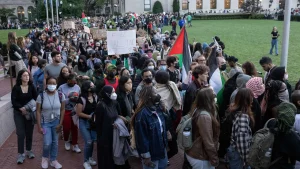Left Voice’s second issue, “Women on the Front Lines”, is now available for purchase. For every magazine sold, we are donating $1 to a worker controlled factory in Argentina.
“When you going to stop selling us out?” Days after police officer Darren Wilson gunned down Michael Brown in August 2014, activists cornered Rev. Jesse Jackson at a McDonald’s in Ferguson. Turning from the urgings of old leaders (to “register to vote,” write their representatives, support progressive Democrats), radical youth instead drove a movement of mass demonstrations, blocked highways, die-ins, commercial disruption, and riots–all during the first Black president’s second term.
The US bourgeoisie’s decades-long failure to ameliorate the fallout from the 2008 economic crisis has struck hard in the heartland. Expanding sectors of the American populace are turning right and left for solutions to their discontents, forcibly altering the country’s political terrain.
Millions of youth and students backed Bernie Sanders’ campaign, seeing in him an alternative to the ruling political order. When he ended his run by endorsing Hillary and diving into the Democratic Party fold, many of his supporters went on in search of socialist organizations, study groups, and protest movements.
The Democratic Socialists of America (DSA) has perhaps been most successful in capturing the rising interest in socialism, in large part because of their clear alignments with Sanders’ wildly popular social democratic program. Jacobin Magazine, arguably the main window into the DSA’s politics, has also served as an important recruitment tool. The organization has tripled in size since Trump’s election, with 18,000 dues-paying members as of March 2017. This impressive growth poses important opportunities and problems for the group and the broader left.
The DSA has attracted a wide range of people–from disaffected liberals, to social democrats, to some who consider themselves revolutionary socialists. Despite this marked heterogeneity, their rapidly expanding ranks show a practical rejection of both bourgeois parties.
At the same time, the more seasoned, consolidated national leadership fastens the organization to the project of the Democratic Party, making no clear class delimitations. As their argument goes, socialists can maintain political autonomy and keep their anti-capitalist aims intact while making conditional alignments with progressive (“anti-corporate”) Democrats: voting, campaigning for Democratic politicians, and even running socialists on their slate. It is thought that empowering “left-wing” Democrats and supporting their progressive demands in the short-term will help break the monopoly of the two-party system and potentiate a left alternative to the Democratic Party.
These electoral maneuvers are often passed off as tactical considerations. But can calling your base to vote for a capitalist party by passed off as “tactic”? Does putting imperialist politicians into government have no bearing on the path to revolution? And how can a socialist organization that works closely with Democrats today fight against the same Democrats tomorrow when they repress, co-opt, and betray workers’ interests?
This, while the Democrats can already be seen shimmying to the front of the anti-Trump movement. Posing as “resistance leaders,” their progressive avatars–Elizabeth Warren, Chuck Schumer, and Maxine Waters–have appeared at protests and even called for mobilizations against GOP policies. Once again, the Dems are taking up the “people’s party” mantle to close the gap between the party and base–to recover their legislative majorities and shake off the Obama presidency’s domestic failures.
The DSA’s “realist” electoral tactics, when examined closely, make up a dead-end strategy for socialists, radicals, and movements that will only result in strengthening the Democratic Party.
Insurgency from within?
The DSA leadership has reiterated on various occasions that the Democratic Party is not the political instrument of the US working class, is tied to capitalist interests, is part of a two-party monopoly, etc. However, their politics point in a different direction.
The DSA has historically tagged along with politicians in the Democratic camp–radical, socialist, or not–as long as they were seen as part of a nebulous progressive bloc.
Today, with the Democratic Party scattered by its recent series of catastrophes (the DNC’s mucking-up of the primaries, Clinton’s defeat, and the loss of both chambers), the DSA’s prescriptions have proven immutable: “Great change is needed within the Democratic Party. The DNC’s gross mishandling of the primary election between Bernie Sanders and Hillary Clinton demonstrates the need for a reinvigorated party that appeals to working-class voters of all races, ethnicities and genders.” [1]
Economic hardship and social contradictions inherent in bourgeois democracy are causing cracks in the ruling parties. When it appears the Democratic Party is going up in flames, revolutionaries and socialists should give their all to make the fire burn hotter. They should be pointing towards the absolute need for working-class organizations and a political party independent of capitalists, on the path towards socialist revolution and a classless society.
The DSA buries this perspective, instead promoting the idea that the Democratic Party will, one day, respond to the needs of the working class, the poor, people of color, etc. And, significantly, they see the left’s role in encouraging this possibility.
Ahead of the February 2017 DNC elections, the DSA openly supported Minnesota Representative Keith Ellison’s bid against Former Labor Secretary Thomas Perez. In doing so, they endorsed a long-term Democrat who in no real terms differentiated himself from his opponent, thus reinvigorating the notion that the Democrats’ path may be corrected by switching out individual figureheads. Upon his defeat, Ellison was appointed Deputy Chair by Tom Perez.
On the other hand, the DSA’s approach also includes bringing socialist leadership into the Democratic fold, with the aim of improving the balance in favor of reforming the party.
At the Michigan Democratic Convention in February 2017, the DSA elected several members to the Democratic Party state central committee. David Green, DSA Detroit chapter leader and National Political Committee member said, “We need a party that’s open to progressive forces, and that’s why we have to elect progressive leadership within the party,”
The myth of rainbows
At the time of Ronald Reagan’s 1980 election, the political situation was moving rapidly to the right. The Democratic Party was in retreat, trying to find the way to recover from the blows. In 1984, the left wing of the Democratic Party and its satellite organizations attempted to win the primaries through the Rainbow Coalition, headed by known Civil Rights Movement figure, Jesse Jackson. The goals of the campaign were to oppose Reaganomics and gain support from Blacks, working-class people, immigrants, women, and the LGBT community.
A significant portion of the left found it necessary to back Jackson’s campaign, or risk missing out on an important political opportunity. Organizations like the US League of Revolutionary Struggle (M-L), Communist Party USA (CPUSA), Line of March (LOM), the Communist Workers Party (CWP) and the DSA endorsed Jackson’s candidacy.
During the ‘84 primaries, Jackson came away with three million votes, including an unexpectedly strong showing from southern states like Mississippi. He lost the Democratic primaries to the establishment pick Walter Mondale, whose candidacy he ended up supporting with the “lesser evil” argument.
In a statement released in November 2016, the DSA National Political Committee referred to the Rainbow Coalition as a model for today’s anti-Trump resistance: “Under Reagan, similar acts of resistance eventually created a powerful rainbow coalition that advanced a multiracial politics of economic and racial justice. If we fully commit ourselves to these struggles over the next four years there is no reason why a new, even more powerful multiracial coalition for social and economic justice cannot emerge.”
The Rainbow Coalition was an example of popular front politics that ultimately breathed life back into the Democratic Party, setting the stage for Bill Clinton’s victory in 1993. Jesse Jackson at the time told the press, “Clinton and a Congress controlled by the Democrats have the opportunity to put America back to work and rebuild America with jobs, education, housing, health care and cleaning up the environment.” Once in office, Bill Clinton thrusted neoliberalism down the throats of the working class. Among other things, he dismantled welfare programs and passed the 1994 Crime Bill that exponentially increased the incarceration of predominantly Black people.
Rather than drawing lessons from these errors, the DSA’s glowing appraisal of the anti-Reagan coalition in fact points to strategic conclusions that weaken the potential for a socialist movement to emerge. This strategy aids the Democratic Party’s recovery of its historical role as diffuser of mass/working-class uprising, and blockade the growth of left political alternatives and the political independence of the working class.
A left in coalition with Democrats can not maintain its political autonomy and determination. Allying with “progressive” capitalist politicians will only lead to the absorption of the left into the political project of big capital.
In bed with the enemy
In January 2017, DSA National Director Maria Svart wrote, “We are strategic about elections and about building power, which means being flexible. We can work with anti-corporate Democrats–and use the Democratic Party ballot line when it makes sense to run democratic socialist local candidates.”
Underlying their practice of sharing slates with the Democratic Party is the electoral pragmatism that has dominated the US left since the 1930s: due to the two-party lock, it is nearly impossible to construct a class-independent alternative. Instead, as the common-sense thinking goes, the left must take a two-stage approach, wherein the first stage permits rapprochement and electoral support of bourgeois politicians to build a progressive base that is sympathetic to socialist ideas. Another aspect of this is the uncritical embrace of “third parties” with no clear class delimitations.
In 1948, Socialist Workers Party leader James P. Cannon criticized this approach and pushed for revolutionaries to focus their immediate efforts on advancing the political independence of the class outside bourgeois parties: “Now, a break-up of the two party parliamentary system in America is undoubtedly a good thing…But this break-up of the two-party system and splits in the bourgeois parties come about under the pressure of social crisis. These are not our tasks. Bourgeois parties are not the arena for our operation. Our specific task is the class mobilization of the workers against not only the two old parties, but any other capitalist parties which might appear.”
At one point in US history, as even DSA Vice-Chair Bhaskar Sunkara pointed out, “Socialism used to be more than a pejorative; it used to be a real political force espousing radical democracy and egalitarian redistribution. In 1912, the Socialist Party of America had 118,000 members and boasted 1,200 elected state officials, including 79 mayors.”
A glimmer of opportunity appeared in 2013 when Kshama Sawant ran as a member of Socialist Alternative and won a seat in the Seattle City Council. She was re-elected for her second term a few years later. This somewhat singular yet recent example points to the potential for the left to boldly advance socialist candidacies and politics instead of settling for running alongside or campaigning behind capitalist politicians.
Opportunities for the left
The current rise in political militancy–seen in a new generation that sympathizes with socialism and the persistence of struggles led by Black people, women, precarious and immigrant workers–has crystallized in the anti-Trump sentiment and opened historic opportunities for the emergence of a revolutionary left. While the DSA is correct in speaking to the millions who voted for Bernie Sanders, it does so while blurring the boundaries between the inside and the outside of the Democratic Party, between the capitalist parties and the working class.
A key problem with the DSA’s approach is their dichotomy of “movements” (for workers’, immigrants’ and women’s rights) on the one hand, and battles in the political superstructure, or elections, on the other. This is shown in their approach to building a mass movement made up of the working class and the oppressed while simultaneously supporting left-wing Democrats: “Positive change never comes from politicians acting alone, but always from masses of ordinary people taking politics into their own hands. We will get the party we need when we build a majoritarian progressive movement…of trade unions, women’s groups, immigrant’s rights organizations, organizations of people of color, with a visible and independent organized socialist movement at its core.” Despite the emphasis on movement-building in their statements and branch meetings, “street heat” serves mainly as a pressure to push Democratic leaders to the left.
Socialists must fight audaciously to influence the mass movement and win over the most radical elements to revolutionary perspectives. Specifically, they must prevent the opposition against Trump from being funneled entirely into capitalist parties or even multi-class formations like the Green Party. The necessary intervention in the anti-Trump movement is to raise an independent politics, especially in relation to the Democratic Party.
The Democrat’s goal is to reconstitute itself in a way that will prevent the escalation of class struggle. Ultimately, diminishing the influence of the Democratic Party on the mass movement and preventing it from rebuilding its social base is the best way to break illusions in bourgeois democracy and prepare mass working class movements for the coming battles.
Developing the resistance against Trump’s attacks with a revolutionary perspective is one and the same as raising the need for the American working class (torn by racism and sexism) to take on the struggle against multiple oppressions that reproduce capitalist domination.
The capitalist parties uphold the American regime and thus are the main enemies of the exploited and oppressed, while the working class has enormous allies in the Black movement against police violence and racism, women who struggle for their emancipation, immigrant workers, and the middle class hit hard by the economic crisis. It is the task of the socialist left to establish the bridge between the need for the US working class to identify itself as a class, clearly distinguish its allies and enemies, and conquer hegemony among the oppressed.












